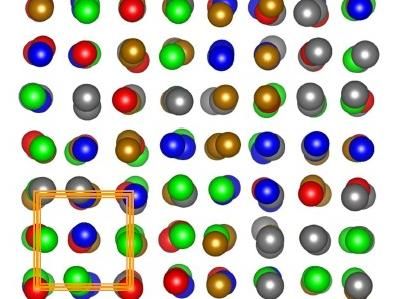High entropy alloys: structural disorder and magnetic properties
"High-entropy alloys are an extremely diverse and exciting class of materials”
High-entropy alloys (HEAs) are promising materials for catalysis and energy storage, and at the same time they are extremely hard, heat resistant and demonstrate great variability in their magnetic behaviour. Now, a team at BESSY II in collaboration with Ruhr University Bochum, BAM, Freie Universität Berlin and University of Latvia has gained new insights into the local environment of a so-called high-entropy Cantor alloy made of chromium, manganese, iron, cobalt and nickel, and has thus also been able to partially explain the magnetic properties of a nanocrystalline film of this alloy.

The Cantor alloy under study consists of chromium (grey), manganese (pink), iron (red), cobalt (blue), and nickel (green). X-ray methods allow to probe each individual component in an element-specific way.
© A. Kuzmin/University of Latvia and A. Smekhova/HZB
High entropy alloys or HEAs consist of five or more different metallic elements and are an extremely interesting class of materials with a great diversity of potential applications (see interview below). Since their macroscopic properties are strongly dependent on interatomic interactions, it is utterly interesting to probe the local structure and structural disorder around each individual element by element-specific techniques. Now, a team has examined a so called Cantor alloy - a model system to study the high-entropy effects on the local and macroscopic scales.
A toolbox at BESSY II
To investigate the local environment of individual components, the team used multi-edge X-ray absorption spectroscopy (EXAFS) at BESSY II and then the reverse Monte Carlo method to analyse the collected data. The magnetic properties of each element of the alloy were additionally probed using X-ray magnetic circular dichroism (XMCD) technique. By conventional magnetometry, the scientists proved the presence of magnetic phase transitions and found some signatures of a complex magnetic ordering with a coexistence of different magnetic phases.
Common trends in bulk and nanofilm samples
The results from the examined nanocrystalline film made of this alloy demonstrate some common trends as compared to a bulk sample, e.g., the largest lattice relaxations of Chromium and still intriguing magnetic behaviour of Manganese, which are consistent with the macroscopic magnetic behaviour of the film.
"High-entropy alloys are an extremely diverse and exciting class of materials”, says Dr. Alevtina Smekhova, physicist at HZB and first author of the paper. “By probing the behaviour of individual components at the atomic scale, we would gain valuable clues for the further development of new complex systems with the desired multifunctionality," she says.
Interview: Three simple questions to Dr. Alevtina Smekhova, first author of the study
What are High Entropy Alloys? The main idea of the whole class of "high-entropy" materials is to mix five or more elements and to see how the macroscopic properties will change. When there are so many elements in one material, it is not possible to tell that there is a "matrix" and there is a "dilute material", so all elements are somehow "equal" for the solid solution, but still behave differently due to their individual properties like the size, charge, number of electrons, electronegativity, etc.
Why are those HEAs so interesting? It was found that many macroscopic properties like mechanical hardness, resistance against irradiation, catalytic activity and many others are significantly improved as compared to conventional alloys. And it seems that all these properties are related to the number of local configurations, which is huge - billions!!!- due to the number of the elements.
Is there already an idea how to use them? Yes, sure. These alloys are heat- and -radiation-resistant, and could be used as different coatings for extreme conditions, for example in reactors, or in aviation. Recent chemistry experiments have shown that HEAs are good for renewable energy applications and for catalysis, for example for water splitting. A lot of people right now are searching for new properties and applications, and the key factor to advance the field is the understanding of how individual components of the alloy behave at the atomic scale. And with X-rays from a synchrotron it is possible to find answers on almost all these questions.
Original publication
Nano Research (2022): Local structure and magnetic properties of a nanocrystalline Mn-rich Cantor alloy thin film down to the atomic scale Alevtina Smekhova, Alexei Kuzmin, Konrad Siemensmeyer, Chen Luo, James Taylor, Sangeeta Thakur, Florin Radu, Eugen Weschke, Ana Guilherme Buzanich, Bin Xiao, Alan Savan, Kirill V. Yusenko, and Alfred Ludwig
Other news from the department science
Most read news
More news from our other portals
See the theme worlds for related content
Topic World Spectroscopy
Investigation with spectroscopy gives us unique insights into the composition and structure of materials. From UV-Vis spectroscopy to infrared and Raman spectroscopy to fluorescence and atomic absorption spectroscopy, spectroscopy offers us a wide range of analytical techniques to precisely characterize substances. Immerse yourself in the fascinating world of spectroscopy!

Topic World Spectroscopy
Investigation with spectroscopy gives us unique insights into the composition and structure of materials. From UV-Vis spectroscopy to infrared and Raman spectroscopy to fluorescence and atomic absorption spectroscopy, spectroscopy offers us a wide range of analytical techniques to precisely characterize substances. Immerse yourself in the fascinating world of spectroscopy!





























































